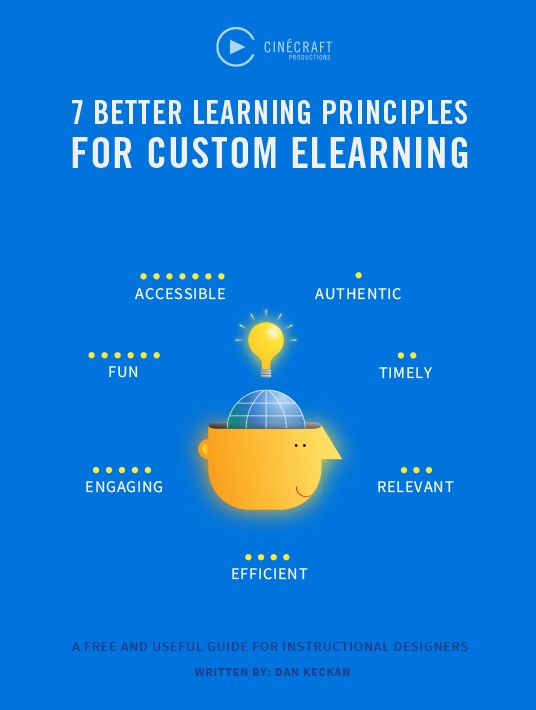Efficient eLearning Takes As Little Of Learners' Time As Possible
James and the L&D team are having a celebratory lunch! They successfully converted their 3-day, instructor-led, manager onboarding program into a custom eLearning curriculum. This project will save the company so much time and money. And, it wasn’t even that difficult to complete. All the content was already in the PowerPoints, so they just had to convert it to eLearning. Everyone gives themselves a pat on the back! Meanwhile, at a store in the Bronx, NY…
Rosa was just promoted to an assistant manager position and now has a team of nine sales associates reporting to her. Go Rosa! She’s excited to lead the team and achieve even greater sales results for the store. Her first day on the job, she’s assigned her “Manager Learning Path” in the company’s LMS. She’s astounded when she sees a list of 15, one-hour eLearning courses! And she has to complete them in the next 30 days!

Rosa’s time is valuable. So, why did James and his team design and implement this program with little consideration for her time? They took the path of least resistance—it was efficient for them, rather than efficient for Rosa.
It's More Work To Be Efficient...Say What?
It may sound counter-intuitive, but designing Efficient learning is more work. It’s easier to make a course that has everything, but the kitchen sink; like James’s team who just took the instructor-led PowerPoints and added voiceover. To create a streamlined and well-organized course, James’s team needed to consider how to achieve the business goal in the least amount of time for the learners. Let’s take one of the many courses in the onboarding program, “Coaching Sales Associates,” as an example. Last year, James’s company launched a new sales training program for all 50,000 store associates worldwide. The course was initially a huge success, but it seems that some associates are slipping into their old habits of not asking customers if they would like to purchase additional items. If motivation and training are not the answer, I think we might all agree that effective coaching may help to reengage associates.
Let’s assume that the organization adopts one of the many models out there in the marketplace. The L&D department identifies the objectives as:
- State the purpose of your discussion
“I was hoping we could briefly discuss your performance around the customer that purchased the widget earlier today.” - Ask the associate their perception
“Tell me about the Customer Experience.” - Describe what the associate did well
“I observed the Customer Experience and you did a great job of asking questions and describing the features and benefits of the widget. In fact, they purchased the widget. Great job!” - Describe opportunities for improvement
“You know we are making a more concerted effort at offering customers accessory widgets to enhance the widget they bought? What can we do to make sure you offer accessory widgets with every customer? It will help us increase sales and really help our bottom line.” - Set a time and date to follow up on the progress
“I’m glad we came to an agreement on a plan for you to increase your accessory widget sales. When can we follow up and have a brief discussion to see how you’re progressing?”
If these are the objectives, does a 1-hour, level 2 eLearning course describing, defining and providing examples of the organization’s strategy help a manager like Rosa coach her team? Nope. You need Rosa to coach, not just define the process.
How Can James Fix It?
The key is to get Rosa as close to the skills and/or behaviors to be demonstrated as possible. Although it will take more time for James to design, he can let Rosa practice coaching in less than one hour by using simulations. Remember, it’s not about James, it’s about Rosa! James should create the simulations in a first-person perspective so that Rosa feels like she’s talking to an associate face-to-face. The background should be realistic and set in the store. Rosa will have a real coaching conversation with the associate and receive corrective feedback to get her on the right track if she selects an incorrect answer. If she selects a correct response, she continues on in the conversation—just like real life. That’s Authenticity at its finest. And, it doesn’t waste her time by letting her know she’s right—she already knows that or she wouldn’t have selected the answer!
As if that wasn’t enough, here are a few more reasons why simulations are the most Efficient solution here:
- They are short, but effective. In less than 10 minutes, Rosa can complete a simulation where she interacts with an employee and gets feedback on her performance. It’s much easier for Rosa to find 5-10 minutes during the day than it is to set aside an hour.
- They get Rosa straight to the content. She doesn’t have to sit through coaching techniques and strategies that she won’t remember anyway.
- You can support simulations with job aids that will help Rosa long after she’s finished the learning. Instead of showing a coaching checklist in an eLearning course, make it a PDF that Rosa can reference when she’s preparing for a coaching conversation. She’ll appreciate the support—and that she didn’t have to sit through a narrator reading the checklist to her.
- If Rosa needs a refresher, because it’s been a while since she has had to deal with a performance issue—she can retake a simulation in 5 minutes. That’s Efficient and Timely—jackpot!
Okay, You've Convinced Me. What's Next?
James and his team need to reevaluate the learning strategy for the entire manager program to find ways to make it more efficient.
They should start by analyzing the content to answer these questions:
- What are the business goals and learning objectives? Cut any content that doesn’t support them.
- How can we change learner behavior and create an Authentic experience in the least amount of time possible?
- How does this content address the learners’ performance gaps? Is it need-to-know or nice-to-know? In other words, is it relevant to my learners?
- Would this content be more Efficient and Timely as a job aid?
Answering these questions will help James—and you—ensure that the learners’ time is valued so that they can get back to their jobs faster and with a honed skillset! If you really want to design an efficient eLearning course, you should download our eBook 7 Better Learning Principles For Custom eLearning to truly optimize your custom eLearning processes. You can also watch the supporting webinar "Maximize Learning Effectiveness Using The 7 Better Learning Principles" and unlock the full potential of performance-based learning.


